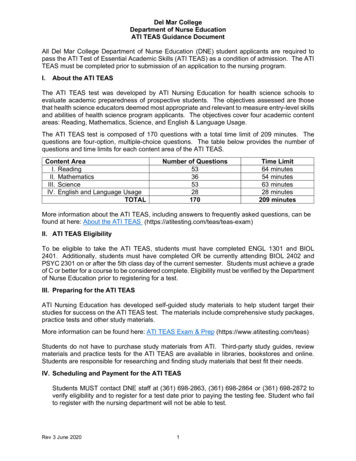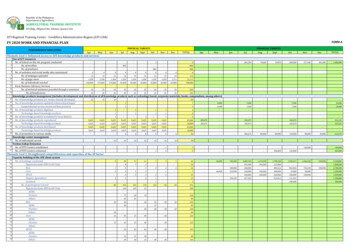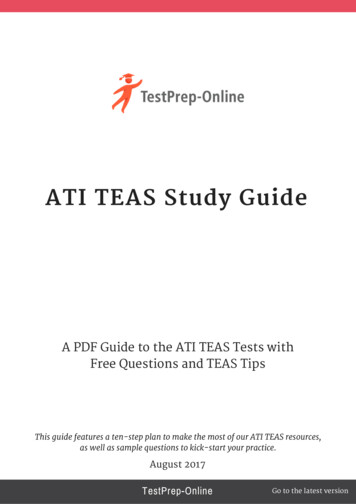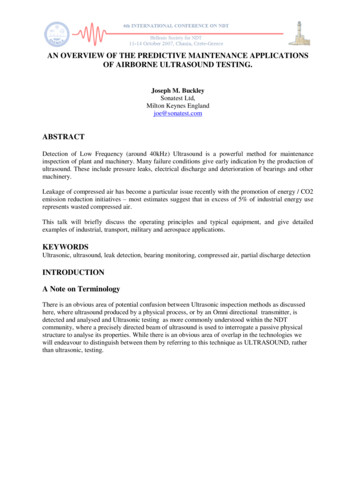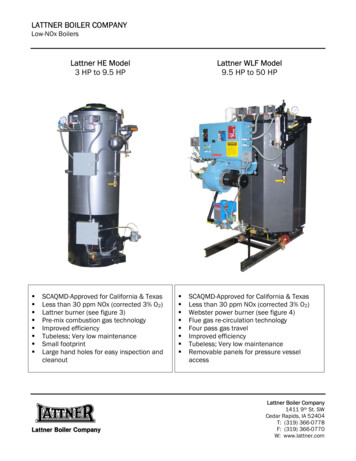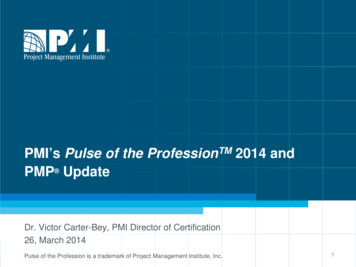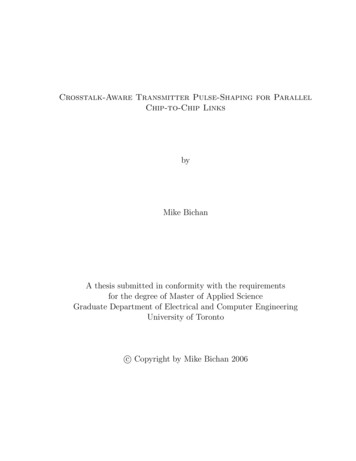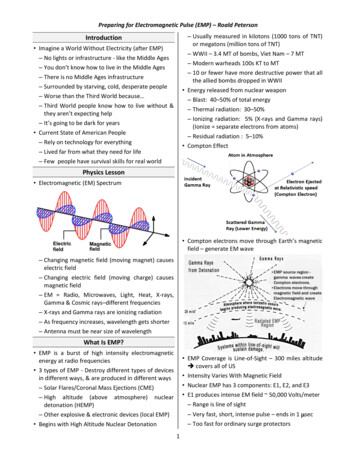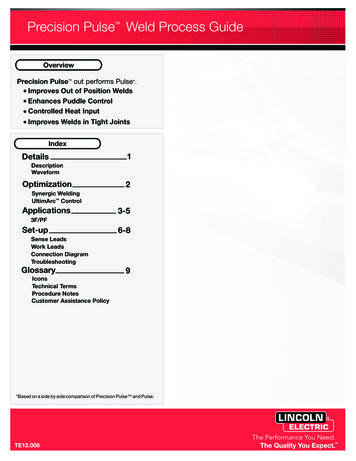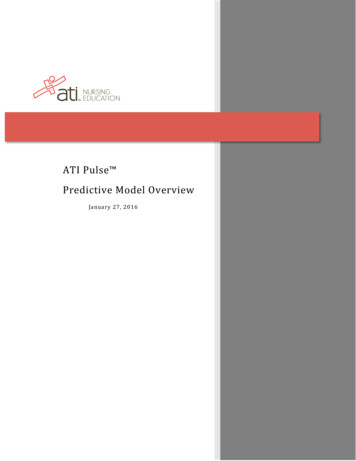
Transcription
ATI Pulse Predictive Model OverviewJanuary 27, 2016
Historically, indications of eventual NCLEX-RN/NCLEX-PN1 success or failure have been restrictedto end of program assessments like Assessment Technology Institute’s (ATI) ComprehensivePredictor.Although a highly predictive instrument that provides individualizedrecommendations for student remediation, ATI’s Comprehensive Predictor is not designed todynamically follow a student through his or her academic career and inform of potential NCLEXRN/NCLEX-PN remediation needs. To address this need and provide indications of whether astudent is on track to pass NCLEX-RN/NCLEX-PN, ATI developed the ATI PulseTM model.The ATI Pulse model is designed to follow a nursing student throughout the duration of his orher academic career. During this progression through nursing school, the ATI Pulse model willprovide individual students with a predicted probability of passing the NCLEX-RN/NCLEX-PN,associated risk categories, and highlight remediation needs. This document outlines several keyfeatures and considerations related to the ATI Pulse predictive model.To develop the Pulse model, ATI conducted an analysis of a limited set of students using ATIproducts. The analysis represented 47,545 students in 1,280 ADN and BSN programs and 29,057students in 894 PN program. Furthermore, all RN students in the analysis were activelypreparing for the 2013 blueprint of the NCLEX-RN and all of the PN students were preparing for2014 blueprint of NCLEX-PN.The goal of this analysis was to determine whether performance on ATI products2 (other thanthe Comprehensive Predictor) might be used to provide students and faculty with earlierindicators of “at risk” status with regard to NCLEX-RN/NCLEX-PN performance. Results of ATI’slarge scale analysis expand upon similar, program-level, efforts exploring how ATI products arepredictive of later NCLEX-RN performance (e.g., McCarty, Harris, & Tracz, 2014; Penprase,Harris, & Wu, 2013). The result of ATI’s national-level analysis was the creation of the predictivemodel: ATI Pulse , which is capable of identifying students who are at risk of NCLEX-RN/NCLEXPN failure both early and throughout their nursing program of studies.The ATI Pulse model provides a predicted probability of passing the NCLEX-RN/NCLEX-PN that isbased on a student’s current and historic performance across several proctored ATIassessments. Predicted probability of passing the NCLEX-RN/NCLEX-PN is a function of astudent’s predicted later performance on ATI’s Comprehensive Predictor assessment and theComprehensive Predictor’s associated predicted probabilities of passing the NCLEX-RN/NCLEXPN. These predicted probabilities of passing the NCLEX-RN/NCLEX-PN were evaluated by a teamof nurse educators and categories of risk status were qualitatively derived. Specifically, nurseeducators viewed students with predicted probabilities of passing the NCLEX-RN/NCLEX-PNgreater than 90% as “on track” and therefore “low risk.” Nurse educators further categorizedstudents with predicted probabilities of passing NCLEX-RN/NCLEX-PN between 80% and 89.9%as having “moderate need of remediation” and at “medium risk.” Lastly, nurse educatorsdeemed students with predicted probabilities of passing NCLEX-RN lower than 80% as having“high need for remediation” and at “high risk” for NCLEX-RN/NCLEX-PN failure (see Table 1).
Table 1. Nurse educator categorization of predicted probability pass, risk categories, andresulting remediation needsPredicted probability of pass groupingsRiskRemediation Needscategory0% to 80% probability of passHigh“High Need for Remediation”80% to 90% probability of passMedium“Moderate Need of Remediation”90% to 100% probability of passLow“On Track”The ATI Pulse product is designed to provide early indications of whether students are on trackto pass the NCLEX-RN/NCLEX-PN. As with any early indicator, it is important to understand howaccurately risk categories, remediation needs, and predicted probabilities of passing NCLEXRN/NCLEX-PN align with actual NCLEX-RN/NCLEX-PN performance. To explore ATI Pulse’srelationship with later NCLEX-RN performance, a comparable predictive model was developedfor the 2010 NCLEX-RN blueprint and historical students’ NCLEX-RN pass/fail status (supplied bypartnering nursing institutions) was examined (see Table 2). This examination of performancewithin an earlier population of NCLEX-RN examinees is ideal in that it provides a unique insightinto a population of students that were not afforded ATI Pulse’s early warnings or identificationof remediation needs. As can be seen in Table 2, the ATI Pulse predicted probabilities of passand risk categories correspond with observed NCLEX-RN outcomes3. Similar efforts to collectstudents’ actual NCLEX-RN pass/fail experiences for the 2013 blueprint are currently underway.Once enough sample is achieved, analysis of ATI Pulse’s relationship with 2013 NCLEX-RNblueprint outcomes will be summarized.Table 2. Student NCLEX-RN performance as a function of Pulse predictive groupingPredicted probability of pass groupingsRisk categoryActual NCLEX-RN % Pass0% to 80% probability of passHigh62.9% (n 377)80% to 90% probability of passMedium87.8% (n 974)90% to 100% probability of passLow97.0% (n 2,580)Note: 2010 NCLEX-RN % Pass n 3,931. Predicted probability of pass is based on ATI Pulse model.For the PN program, a similar predictive model was developed for the 2011 NCLEX-PN blueprint,and historical students’ NCLEX-PN pass/fail status was examined (see Table 3). Although samplesize is low, nevertheless “shows a similar trend” as in NCLEX-RN. The NCLEX-PN success rate ishigher for the students identified under “Low” risk categoryTable 3. Student NCLEX-PN performance as a function of Pulse predictive groupingPredicted probability of pass groupingsRisk categoryActual NCLEX-RN % Pass0% to 80% probability of passHigh64.2% (n 106)80% to 90% probability of passMedium89.1% (n 230)90% to 100% probability of passLow97.8% (n 945)Note: 2011 NCLEX-PN % Pass n 1,281. Predicted probability of pass is based on ATI Pulse model.By the end of a student’s academic journey, he or she will have ideally provided the ATI Pulsemodel with values associated with the following proctored assessments: ATI’s Test of EssentialAcademic Skills (TEAS V) and ATI’s Content Mastery Series Assessments (Fundamentals, Adult
Medical Surgical, Leadership, Maternal Newborn, Mental Health, Nursing Care of Children,Community Health, and Pharmacology). Depending on the academic tenure of a nursingstudent, more or less data will be available to be entered into the ATI Pulse predictive model.Although the ATI Pulse model will maintain a high degree of accuracy when data from only a fewassessments are available, the predictive accuracy is made more precise when all Pulse relatedtests are administered.Since the NCLEX-RN’s inception, predicting students’ later performance on the assessment hasbeen the focus of both small and large scale research studies. Although successfully predictingwhich students will pass NCLEX-RN has been repeatedly achieved with relative ease, successfullyidentifying which students will fail the NCLEX-RN has proven more difficult (e.g., Seldomridge, &DiBartolo, 2004; Spurlock & Hunt, 2008) and commonly only results in between 33% and 50% offuture NCLEX-RN failures being correctly identified. When evaluating ATI’s Pulse model’s efficacyusing a historical sample of students individual predicted probabilities of passing the NCLEXRN/NCLEX-PN were aligned with specific risk categories (i.e., low, medium, and high risk). Basedon these risk categories, we can see that between 71% and 82% of the students that failed theNCLEX-RN were identified as either moderate or high risk (see Figure 1). This means that, hadATI Pulse been in place within these students’ programs of study, potential earlier remediationinterventions could have been identified and implemented to improve student outcomes on theNCLEX-RN. Also of note, between 18 and 28% of students failing the NCLEX-RN were categorizedas being low risk for NCLEX-RN failure. It is important to note that “low” risk does not imply “no”risk or a predicted probability of passing the NCLEX-RN equaling 100%. As such, it is completelywithin expectations that some students failing the NCLEX-RN were previously categorized as lowor medium risk.Figure 1. ATI Pulse risk categories for students that went on to fail the NCLEX-RN.% of studentsCategorized as High Risk100%90%80%70%60%50%40%30%20%10%0%Categorized as Moderate Risk18%28%33%37%49%Of those failing NCLEX-RN(students with 1 or fewermissing assessments)Categorized as Low Risk23%35%34%42%Of those failing NCLEX-RN(students with 2 missingassessments)Of those failing NCLEX-RN(all students, regardless ofamount of missing data)Note: Fail status is based on NCLEX-RN 2010 blueprint and its associated ATI Pulse predictive modeling.Fail status was collected by participating institutions. Overall n 337; 1 or fewer missing assessments n 163; 2 missing assessments n 174 students failing NCLEX. 2013 blueprint pass fail status is currentlybeing collected.
Risk category analysis on historical NCLEX-PN fail status is shown in Figure 2. 75% of studentfailing NCLEX were categorized under moderate or high risk.Figure 2. ATI Pulse risk categories for students that went on to fail the NCLEX-PN.Note: Fail status is based on NCLEX-PN 2011 blueprint and its associated ATI Pulse predictive modeling.Fail status was collected by participating institutions. Overall n 84; 1 or fewer missing assessments n 30; 2 missing assessments n 54 students failing NCLEX. 2014 blueprint pass fail status is currentlybeing collected.Based on results displayed in Table 2 and Figure 1&2, it can be concluded that the ATI Pulsemodel accurately classified the majority of remediation needs for students based on theirhistorical performance on ATI proctored assessments. Specifically, 97% of students within thelow risk category went on to successfully pass the NCLEX-RN on their first attempt. Furthermore,up to 82% of students that went on to fail the NCLEX-RN on their first attempt were classified as“moderate” to “high risk” and in need of NCLEX-RN related remediation. These findings suggestthat ATI’s Pulse Model is an effective approach for gaining earlier insights into later NCLEX-RNperformance. As ATI Pulse functions as an early indicator of later Comprehensive Predictorperformance, it is important for students to receive a final Comprehensive Predictor basedprobability of passing NCLEX-RN/NCLEX-PN4. In addition to providing a final probability ofpassing the NCLEX-RN/NCLEX-PN (vs. a predicted probability), the Comprehensive Predictor alsoprovides students with NCLEX style questions and targeted study materials that are mapped toindividual knowledge gaps immediately prior to taking the NCLEX-RN/NCLEX-PN assessment.ATI recognizes its unique ability to understand key indicators of academic performance acrosstens of thousands of nursing students annually. We are proud to continue to be able to providestudents and faculty better tools by which successful remediation can be achieved. Through ATIPulse, we are confident that we can help empower students to act earlier in order realize theirNCLEX-RN/NCLEX-PN goals!
Notes:1 NCLEX,NCLEX-RN and NCLEX-PN are registered trademarks of the NCSBN.2 ATI assessments included were ATI’s Test of Essential Academic Skills (TEAS V) and ATI’s Content MasterySeries Assessments (Fundamentals, Adult Medical Surgical, Leadership, Maternal Newborn, MentalHealth, Nursing Care of Children, Community Health, and Pharmacology).3 As Pulse usage increases, more data will become available. This document’s analyses represents asnapshot in time and analytical optimization of Pulse prediction will be ongoing. As ATI continues withPulse development, enhancements, new features, and different functionality may be introduced.The primary purpose of ATI Pulse is to provide additional prediction and validation of nursing studentperformance, as well as continuous opportunities to offer targeted remediation. Accordingly, Pulse is notintended for use in a "high stakes" fashion, nor should it be used to screen students out of a program orto penalize students for their lack of ATI product use. Of course, as with all testing and predictive tools,ATI Pulse findings and indicators come with a margin of error that is both common and expected andresults from a variety of factors. Administration of ATI’s TEAS assessment and all of ATI’s Content MasterySeries proctored test subjects will lead to more accurate Pulse predictions. While the predictive analysisof Pulse will offer meaningful data to school faculty and administrators, it should never be used as a solecriterion for evaluating student performance.4
Frequently Asked Questions1. Are there different ATI Pulse models for students enrolled in a BSN vs. in an ADNprogram?Although the same methodology and analytical processes were used to create BSN andADN versions of the ATI Pulse model, separate predictive algorithms exist for studentsenrolled in ADN vs. BSN programs. The different predictive algorithms emphasize ordeemphasize certain predictors of later NCLEX-RN success as a function of how theyperform analytically within these two different student populations. Despite ATI Pulse’sprogram-specific weighting of predictors, comparable predictive accuracy is achieved forboth ADN and BSN program types.2. Does the ATI Pulse model include students’ GPA or course grades?Although frequently found to be a predictor of later NCLEX-RN/NCLEX-PN performance,GPA and/or course grades are not part of ATI’s Pulse predictive model. The reason fornot including these grade based metrics is two-fold. First, distribution of course grades(and therefore GPA) are likely to vary as a function of faculty grading difficulty. As aresult, course grades highly predictive of NLCEX-RN/NCLEX-PN success at one institutionmay only be marginally predictive at another institution. The second reason for notincluding GPA or course grades is that ATI does not have broad access to students’grades or overall GPA data. Combined, these analytical hurdles prevent GPA or coursegrades’ inclusion into the Pulse product.3. What if my program does not use one or more of the assessments that are part of the ATIPulse model?The ATI Pulse model’s accuracy is negatively impacted by greater amounts of missingdata; however, values for missing assessments can be estimated (i.e., imputed) andstudents are still provided with predicted probabilities of passing NCLEX-RN/NCLEX-PN. Itis strongly recommended that ATI Pulse users strive to use all ATI products includedwithin the predictive algorithm. Increased use of the designated ATI products willimprove the predictive outcomes of ATI Pulse.4. Does the ATI Pulse model require that proctored assessments be administered in a certainorder?Other than the Test of Essential Academic Skills (TEAS V) being administered as part of abroader admissions screening process, all other ATI assessments included in the ATIPulse model can be administered in any order during the course of a nursing student’sacademic career.5. Why don’t ATI tutorials or practice tests factor into the ATI Pulse’s predicted likelihood ofpassing the NCLEX-RN/NCLEX-PN?Although significant positive outcomes are associated with ATI tutorials and practicetests, ATI actively chose to not include these products in this version of the ATI Pulse.Currently, the conditions under which tutorials and practice tests are used do not haveenough consistency across programs or products. Although some programs willintegrate tutorials and/or practice tests into coursework and graded assignments, otherprograms will not have any policy regarding tutorial or practice test usage. ATI isfrequently unaware of the nuances associated with these faculty level decisionsregarding product usage. As such, only proctored examinations were included in the ATIPulse model.
6. How can students go about increasing the ATI Pulse computed predicted probability ofpassing the NCLEX-RN/NCLEX-PN?ATI Pulse only uses a student’s first attempt proctored score for each ATI assessmentwhen computing the predicted probability of passing NCLEX-RN/NCLEX-PN statistic. Dueto variability in nursing programs’ policies regarding tutorials usage or 2nd or greaterattempts on proctored assessments, ATI is unable to reliably model this type of data.Despite this analytical limitation, ATI encourages programs to build student remediationplans that include retesting on content mastery or TEAS assessments when lower thandesired performance was achieved during the first proctored examination. In addition topotentially allowing students multiple attempts on proctored assessments, students andfaculty can use the ATI Pulse dashboard to understand which remediation tools (e.g.,tutorials) are available. Although subsequent remediation efforts are designed toincrease students’ nursing content mastery, these behaviors are not currentlytranslatable into an analytical change in a student’s predicted probability of passingNCLEX.7. May I get a copy of the ATI Pulse methodologies and formulae?Thank you for your interest in our model and the exciting promise it offers!Unfortunately, the ATI Pulse model, its methodologies, and its underlying analyticaltechniques are proprietary and may not be distributed.8. Does student prediction in Pulse start with the first student data point that is available(e.g., TEAS V)?Research studies have shown that the TEAS is predictive of early nursing programsuccess when compared to students’ performance on the ATI Fundamentals proctoredassessment. Realizing that a number of factors influence nursing program completionand ultimate NCLEX success, TEAS data on its own cannot speak fully to a student’slikelihood of NCLEX success. When the TEAS is placed within ATI’s Pulse model an earlypredicted probability of passing the NCLEX-RN/NCLEX-PN is presented. It is important tounderstand this early prediction needs to be kept within the context of the Pulse modelto allow for further completion of additional data points. This early prediction is to aid insupporting student program success, not meant to inform admission guidelines ortrends.ATI’s Pulse model provides a predicted probability of passing the NCLEX-RN/NCLEX-PNthat is based on a student’s historic performance across several proctored ATIassessments. Predicted probability of passing the NCLEX-RN/NCLEX-PN is a function of astudent’s predicted later performance on ATI’s Comprehensive Predictor assessment andits associated predicted probabilities of passing the NCLEX-RN/NCLEX-PN. Depending onthe academic tenure of a nursing student, more or less data will be entered into the ATIPulse predictive model. In cases where fewer data points are available for the model, astudent’s earlier performance on proctored assessments is used to proactively predictfuture performance. In cases where only one assessment is available (e.g., the TEAS Vadmissions assessment), relative performance on this single assessment will be used topredict later proctored assessment performance. As the student continues to progressthrough his or her program of study, missing data points in the Pulse model aregradually replaced with values reflecting actual student performance on ATI proctoredassessments. As more data becomes available to the Pulse model, more preciseprediction is achieved.
ReferencesMcCarthy, M. A. , Harris, D., & Tracz, S. M. (2014). Academic and nursing aptitude and theNCLEX-RN in baccalaureate programs, Journal of Nursing Education, 53,151-159.Penprase, B. B., Harris, M., & Qu, X. (2013). Academic success: Which factors contributesignificantly to NCLEX-RN success for ASDN students? Journal of Nursing Education and Practice,3, 1-8.Seldomridge, L. A. & DiBartolo, M. C. (2004). Can success and failure be predicted fo
The ATI Pulse model is designed to follow a nursing student throughout the duration of his or her academic career. During this progression through nursing school, the ATI Pulse model will provide individual students with a predicted probability of passing the NCLEX-RN/NCLEX-PN, associated risk categories, and highlight remediation needs.
